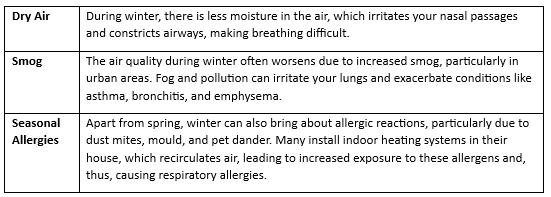How Does Seasonal Change Affects Chronic Respiratory Conditions?

How Does Seasonal Change Affects Chronic Respiratory Conditions?
Do you know that our environment, especially seasonal changes, influences our health? Seasonal changes bring changes in air humidity and weather, making it difficult for some human bodies to adapt in time. Therefore, such humans are more vulnerable to medical ailments, particularly respiratory conditions. It's because changing seasons create an ideal environment for bacteria and viruses that cause respiratory illnesses to activate.
For people living with chronic respiratory conditions, climate change can worsen symptoms or cause flare-ups. Every season has different difficulties, from the heavy pollen counts during spring to the dry air and pollution during winter.
But knowing how seasonal changes impact your respiratory system can help you manage your symptoms and preserve your respiratory health. Read on to learn more. Read on to learn more.
The Seasonal Impact on the Human Respiratory System
Changes in seasons cause erratic fluctuations in the temperature, from hot to cold and from sunny to rainy. Your immune system can be weakened by these temperature swings, leaving you more susceptible to respiratory ailments.
Let’s understand how varied seasonal changes can affect respiratory diseases:
- Spring: Springtime brings pollen from blooming flowers and trees, which can cause allergic reactions in some people and worsen asthma symptoms. Also, this season sees a high number of allergic rhinitis cases, causing breathing difficulties, coughing, and wheezing.
- Summer: The humidity level rises dramatically during the hot months, making the air heavy enough to aggravate breathing problems for asthmatics or COPD patients. Your throat can potentially feel dry in summer because of low water levels in your body. And dry mucous membrane attracts respiratory disease-causing pathogens.
- Autumn: The dry, cool air in autumn can irritate your airways, causing respiratory issues, especially if you are diagnosed with chronic lung infections. This time of year also presents a significant challenge for mould spores because of the decaying leaves and moist surroundings.
- Winter: Winter is particularly harsh on your respiratory system because it brings along a combination of factors like cold, dry air, indoor heating, smog, and increased pollution levels.
Now that winter is about to set in, let’s understand how the drop in temperature can affect respiratory conditions.
During cold, humid climates, cold viruses easily grow and spread. And your respiratory tract is where many of these pathogens find it easier to enter when you breathe. It’s why you most likely experience symptoms like cold, cough, or sore throat when the weather changes. Even a study by the Seasonal Waves of Respiratory Disorders (SWORD) found that respiratory tract infections are 13.3% more relatively common in winter.
Besides this, many other factors can worsen your respiratory system in winter, and these factors are:

Long-term conditions, chronic respiratory ailments affect your airways and lungs, making breathing difficult. Variations in seasons lead to fluctuations in climate and temperature, which can further trigger the symptoms of these conditions.
What respiratory conditions can you suffer from with the changing season? Read to discover some common chronic respiratory conditions affected by seasonal changes:
- Respiratory Tract Infections
Respiratory tract infections (RTIs) comprise infections that occur in your lungs, nose, chest, throat, and sinuses. Rhinitis, chronic bronchitis, and chronic sinusitis are some common RTIs usually caused by bacteria or viruses spreading during seasonal changes.
- Chronic Bronchitis: Do you suffer from chronic bronchitis? It's because of inflamed bronchial tubes, which leads to a persistent cough and mucus production. With the air getting drier and the temperature getting colder, you can experience worse signs.
- Allergic Rhinitis: Also known as hay fever, this condition occurs due to inflammation in the nose caused by allergens such as pollen, dust mites, and mould. People with allergic rhinitis often find their health deteriorating more in spring and autumn because of high pollen counts and mould spores.
- Sinusitis: Is the tissue lining the sinuses inflamed or swollen? You might have sinusitis. While this medical condition can be triggered by a cold or allergies, dry air and indoor heating during winter can dry out your nasal passages, increasing your sinusitis risk.
2. Asthma
Asthma is a chronic condition where breathing becomes challenging due to the persistent inflammation and narrowing of the airways. Changes in weather, particularly from autumn to winter, when pollen counts are high or cold air irritates your lungs, can trigger asthma attacks.
3. Chronic Obstructive Pulmonary Disease (COPD)
COPD is a group of ailments like emphysema and chronic bronchitis. During colder months, COPD patients usually experience acute or progressive worsening of respiratory symptoms, particularly sputum purulence, dyspnea, and sputum volume. Also, healthcare professionals regularly see complaints of symptoms like sore throat, wheezing, nasal discharge, coughing, and fever whenever the season changes.
How to Prevent Chronic Respiratory Diseases When the Season Changes?
You can manage chronic respiratory conditions or even prevent them by practising self-care, especially during seasonal changes. Whenever the season is about to change, start adopting the following preventive measures to reduce your risk of stimulating chronic respiratory conditions:
- Minimise Smog Exposure: You know that fog and pollutants can irritate your nasal passage and airways, triggering chronic respiratory ailments. So, the first thing you can do to prevent respiratory or lung infections is to stay indoors when smog levels are high. Also, use an air purifier in your house to improve indoor air circulation and quality.
- Keep Your Body Warm: Do you have to go outside? Don’t leave your house without wearing a scarf or covering your mouth with a mask. Doing this will help trap heat and moisture from exhaled breath, preventing airways and lungs from getting dry and reducing irritation. Also, bathe with warm water and dry your body properly before dressing.
- Stay Hydrated: Drinking plenty of water will help keep your mucous membranes in the respiratory tract moist. You should take care of your body’s water level, particularly during dry seasons like autumn and winter, as hydration can help thin mucus and prevent airway irritation.
- Practice Yoga and Breathing: You are cooped up inside because of the high smog and pollution index? You want to work out but are unsure what activities can be done indoors? If your aim is to support your respiratory wellbeing, consider doing yoga and breathing exercises. Also, try steam inhalation! It will moisten your nasal passage and keep viruses and bacteria out of your airways.
- Make Sure You're Eating Right: To strengthen immunity and shield yourself against respiratory ailments, eat more fruits, veggies, and whole grains.
- Maintain Indoor Cleanliness: Regularly cleaning your home can reduce dust, mould, and other allergens that might trigger your respiratory symptoms. Be sure to vacuum frequently and wash your bedding regularly to minimise exposure to dust mites.
- Rinse Your Hands and Nose and Gargle: You should rinse your nose and gargle using 0.9% physiological saline to kill respiratory disease-causing bacteria and clean your nasopharyngeal cavity. Moreover, pathogenic microorganisms can be prevented from spreading by practising regular hand washing.
All-in-All
As the season shifts, many environmental factors like pollen, humidity, dry air, and pollution can influence our respiratory system, sometimes triggering respiratory ailments. By following the above-discussed preventive measures, you can reduce your risk of contracting chronic respiratory illnesses. Now that the season is changing, do you feel your COPD symptoms being triggered? Seek medical assistance for effective chronic obstructive lung disease treatment at Medanta.






